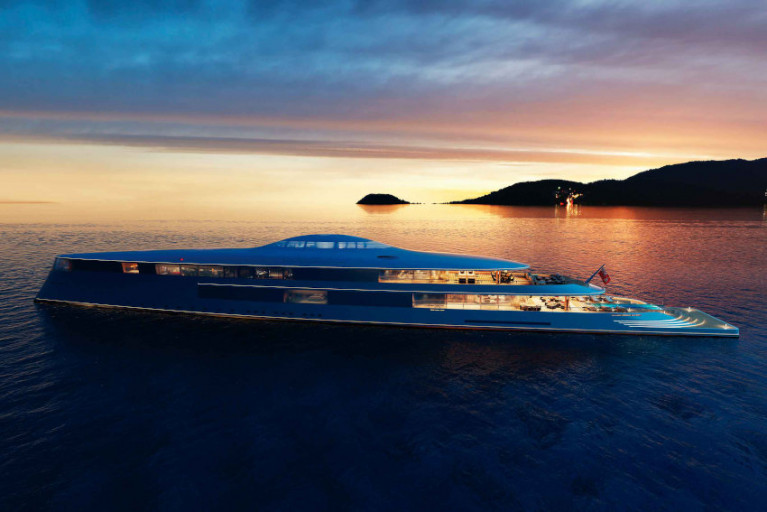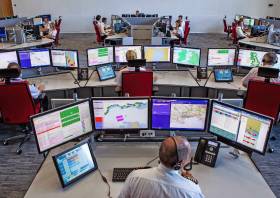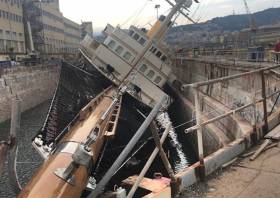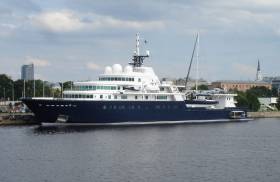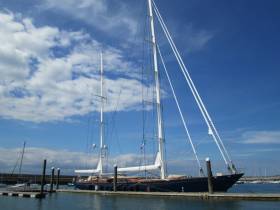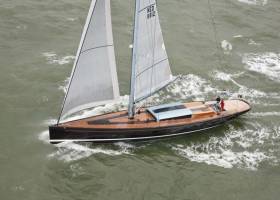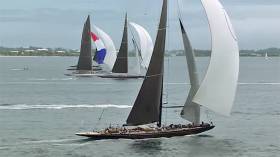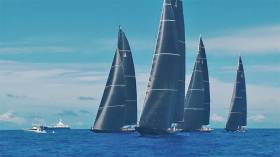Displaying items by tag: Superyachts
Royal Cork's Nin O'Leary together with Cian Guilfoyle of Dublin Bay and other Irish crew are lying third on Aragon in the Loro Piana Superyacht Regatta this week.
The Costa Smeralda put on its best show to deliver a second unforgettable race day for the fleet. A fresh wind from east-southeast of around 15 knots, sunshine and clear skies made for ideal sailing conditions, and perfectly highlighted the incredible scenery that this part of Sardinia is famous for.
As Afloat reported previously, the Irish crew are racing the latest 29-metre Aragon at the prestigious Italian regatta.
Dun Laoghaire Harbour's Cian Guilfoyle came fresh from the RC 44 Cup as Afloat reported here, to join the Aragon team for the first time. His knowledge of handling 400+ square metre spinnakers will see Guilfoyle assisting a bow army of six crew.
Yesterday, there was a spectacular and challenging course of around 30 miles was set by the Race Committee, which included an upwind leg to the islands of Mortorio and Soffi, before returning past Porto Cervo, through the Bisce pass to the Secca Tre Monti in the Golfo delle Saline, and from there leaving the Monaci islet to starboard and heading back to the finish line off Porto Cervo.
The Southern Wind fleet set off at 11.30 a.m. for their daily sail in the SW Rendezvous and Trophy, which in part followed the race route: once through the Bisce pass, the yachts from the South African yard headed for the bay of Liscia di Vacca and returned to port towards evening.
The Multihull division started on schedule at 12.30 p.m., with the Gunboat 68 Highland Fling pulling ahead from the off and gradually stretching her lead to claim first place in both real and corrected time
The Superyacht division's staggered start saw individual departures spaced 3 minutes apart, with the fastest boat being the last off the line.
Victory in corrected time once again went to Missy, the 33-metre yacht designed by Malcom McKeon and built by Vitters, which with two wins now sits firmly at the top of the provisional rankings. Claiming second place of the day, the Swan 115 Shammana also sits in second in the general classification followed by the SW94 Aragon in third. Y3K, which placed second yesterday, was forced to retire today due to a technical issue, causing it to slide into fourth in the provisional overall classification.
Eco-Friendly Superyacht ’Not Sold To Bill Gates’
Multi-billionaire Bill Gates has not commissioned an eco-friendly luxury superyacht that’s powered entirely by liquid hydrogen, the boat’s creators insist.
First unveiled at last autumn’s Monaco Yacht Show, the futuristic Aqua is a 370ft, five-deck mega-yacht with room for 14 guests and more than twice as many crew.
As it would be powered from two massive vacuum-sealed tanks of liquid hydrogen, its only emissions will be water.
Designer Sander Sinot says he hopes the Aqua concept will push the industry towards a more ecological future.
But his company rubbished reports that the vessel had been sold to the Microsoft tech magnate — although its eye-watering $645 million price tag would be pocket change to the 64-year-old, who is the world’s second richest man.
Superyacht Sinking In Indonesia Sparks International Search Operation
HM Coastguard in the UK was among the agencies joining an international search operation last night (Friday 22 November) after a superyacht sank off Indonesia.
While initially believed to be a UK-registered vessel, it was quickly confirmed that the yacht, named Asia, was a Malaysian-registered sailing vessel with two British citizens among the four people aboard.
Following “extensive investigation work” by HM Coastguard, contact was made with the boat’s skipper at 5am this morning (Saturday 23 November).
He confirmed that the vessel sank after hitting an object in the water some 55 nautical miles off an Indonesian island, but all four crew had managed to get in board its RIB tender and were met by marine police at the nearest landfall.
“We are relieved to hear that the crew are now safely ashore,” said HM Coastguard Controller David Jones, who was in charge of co-ordinating efforts overnight.
“This incident demonstrated good international working between the UK Maritime Rescue Coordination Centre, JRCC Australia, JRCC Jakarta, USA Mission Control Centre and the UK Foreign and Commonwealth Office.”
Denis O’Brien Superyacht In Listing Incident At Italian Dry Dock
Four people were reportedly injured when a superyacht owned by Irish media mogul Denis O’Brien listed while being relaunched from a dry dock in Italy.
According to Boat International, the 90-metre Nero was in the process of being moved out of the dock at Amico & Co in Genoa yesterday (Tuesday 10 September) when a support panel apparently gave way, causing the vessel to list dangerously in the dock on its port side.
It’s not yet known what damage has been caused to the popular charter yacht, part of the 1920s-inspired Corsair range, which was purchased by Denis O’Brien in 2014 for around €40 million and underwent a significant refit in Barcelona in 2016.
A statement from Döhle Yachts, which manages Nero, says the yacht listed at a 30-degree angle but "did not contact the dock wall and appears to have suffered only minimal damage".
The statement added that there was no risk to the environment and "no serious injuries" were sustained, with all crew safely disembarking after the incident, which is under investigation.
This story was updated on Thursday 12 September to include the statement from Döhle Yachts.
‘World’s Largest Private Yacht’ Arriving At Cork City Quays
The Port of Cork has advised of traffic delays on Cork’s city quays with the pending arrival of what’s being described as the world’s largest private yacht in the city this morning (Wednesday 12 June).
Le Grand Bleu arrived in Cork Harbour earlier this week as did fellow superyacht AIR, no stranger to the area.
Once owned by Russian billionaire Roman Abramovich, the 113-metre Le Grand Bleu has been in the possession of his friend and fellow oil business mogul Eugene Shvidler since 2006.
The Bermuda-flagged vessel is so sizeable that it even has room to carry two other boats on their own cranes: a 22-metre sailboat and a 21-metre powerboat.
Superyacht ‘Christopher’ Returns To Dun Laoghaire
#Superyachts - Afloat.ie has learned that superyacht Christopher is moored in Dun Laoghaire Marina this morning (Monday 13 August) after passage from Belfast.
The 46m Ron Holland-designed cruising ketch previously sailed into Dublin Bay in June 2014, when it was considered Dun Laoghaire’s largest ever visiting yacht.
Since then the marina has hosted various other super-sized vessels — including the 35.8m Arcadia, a yacht sturdy enough to transit the Northwest Passage — which prompted Afloat.ie to ask whether a dedicated superyacht berth could be a realistic proposal for Dun Laoghaire.
Superyacht ‘Tulip’ Berths In Dun Laoghaire Marina
#Tulip - Dun Laoghaire Marina yesterday (Friday 13 July) welcomed the arrival of the K&M superyacht Tulip for a brief visit.
Designed by German Frers Jr and launched in 2012, the luxury 88-footer has the appearance of a classic sloop above the water line, but below has a flat hull and rising keel that makes for top racing performance when required.
Tulip usually plies the gold and blue coasts of the Mediterranean, can be chartered with a crew of two and room for up to six guests across its three cabins — if money is no object.
Does ‘Cool Route’ Have Its Figures Right In Moves On Superyacht Market?
#CoolRoute - The growing superyacht market is a target audience of the new Cool Route initiative, which is pitching the string of coastal marinas between Ireland and Norway as a top-tier cruising destination.
But is the project’s research up to snuff? Not according to SuperyachtNews’ Rory Jackson, who argues that the scheme’s moves towards the premium superyacht tourism business are naive, and not based on accurate figures.
“[To] describe the opportunities provided by the superyacht market as ‘low hanging fruit’ highlights an incredibly ill-conceived understanding of how the superyacht market operates,” writes Jackson, who also queries the project’s strategy report on its high estimates for superyacht prices, whether to own or hire.
There can be no denying that the Cool Route has a lot to offer superyacht owners,” he adds. “But, any attempt to lure superyachts on an increasingly regular basis must not be rushed.”
SuperyachtNews has more on the story HERE.
#AmericasCup - Lionheart sailed to the top place in the J Class in yesterday’s final round of the America’s Cup Superyacht Regatta in Bermuda.
The team behind the Dutch yacht – which features Volvo Ocean Race veteran Bouwe Bekking as its longtime tactician – saw their consistent performance over the three days put them in good stead.
They will look to redouble their efforts next week to take home a specially commissioned relief map of Bermuda handcrafted by Latitude Kinsale, as previously reported on Afloat.ie.
Update 20/6: An earlier version of this post incorrectly stated that the J Class Prize was being contested in the Superyacht Regatta; instead, the J Class have their own regatta which began on Monday 19 June.
#AmericasCup - Hanuman rebounded from a false start to claim victory in the first round of the America’s Cup Superyacht Regatta in Bermuda yesterday (Tuesday 13 June).
Optimised for expected light conditions, the J Class fleet leader was quick despite the patchy breeze of 5-9 knots, catching up with classmate Velsheda after the first windward mark when their kite-setting failed, and passing Ranger to take the line.
Topaz, who also started near the committee boat with Velsheda and Hanuman, slipped down to fifth, while Lionheart overcame early struggles to place fourth.
All five yachts — plus Svea, expected to join the fleet today (Wednesday 14 June) — will be competing for their own J Class prizes next week, represented by exquisitely detailed 3D maps of Bermuda commissioned from relief chart specialists Latitude Kinsale.
Racing for the J Class among the larger superyacht fleet continues this afternoon with round two, and concludes with the third and final round tomorrow (Thursday 15 June).
In other news from Bermuda, Land Rover BAR Academy placed second in the final standings of the Pool B qualifiers in the Red Bull Youth America’s Cup.
The handpicked team now have a few days to prepare before the final series races from Tuesday 20 to Wednesday 21 June.
Update 20/6: An earlier version of this post incorrectly stated that the J Class Prize was being contested in the Superyacht Regatta; instead, the J Class have their own regatta which began on Monday 19 June.


























